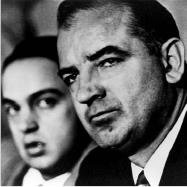Eras and Their HighlightsThe Cold War |
What were the hallmarks of the Cold War era? |
At home, the hysteria of the Cold War era reached its height with the so-called McCarthyism of the 1950s; historian Doris Kearns Goodwin described it as “one of the most destructive chapters in American political history.” In early 1950 Republican senator Joseph McCarthy (1908–1957) of Wisconsin claimed to possess a list of more than two hundred known communists in the U.S. State Department. The startling accusation launched congressional inquiries conducted by the senator’s subcommittee and the House Committee to Investigate Un-American Activities. Suspicions of communist subversion ran high—even in Hollywood, where a “blacklist” named those who were believed to have been involved in the communist Party. Mccarthy never produced his laundry list of offenders in the State Department, and the sorry chapter was closed when, on live television, the senator’s bitter attacks went too far: In televised hearings in 1954, the senator took on the U.S. Army, determined to ferret out what he believed was a conspiracy to cover up a known communist in the ranks. Faced with Mccarthy’s slanderous line of questioning, Army counsel Joseph Welch (1890–1960) delivered a reply that finally disarmed Mccarthy, saying “Have you no sense of decency, sir? If there is a God in heaven, your attacks will do neither you nor your cause any good.” The retort was met with applause in the courtroom, heralding the end of the communist-in-our-midst hysteria.
But the Cold War deepened during the course of the 1950s, as distrust on both sides was increased by the shadow of possible nuclear destruction. Both the United States and the Soviet Union funneled vast resources into the development of weapons systems, as each side believed deterrence would determine the victor in the cold War: It would be won by the nation able to create weapons so powerful that the other nation would be deterred from attacking. The military build-up became an all-out arms race.
competition between the Eastern bloc and the West spilled over into athletics, the arts, and the sciences. In 1957 the Soviets beat the West into space with the launch of the first artificial satellite, Sputnik, which they followed in 1961 by completing the first successful manned space launch. The United States responded by stepping up its space program and vowing to put a man on the moon.
Events in the early 1960s heightened tensions between the two sides, causing many to fear the war would turn hot: When an American U-2 spy plane was shot down over the Soviet Union and its pilot was captured in 1960, the United States was forced to admit to conducting a program of aerial reconnaissance; in 1961, the U.S.-backed invasion of Cuba, known as the Bay of Pigs, failed, revealing American involvement in the plot; also that year, the Berlin Wall was built to stop the flow of emigrants out of East Germany, and becoming a visible symbol of the division between East and West; and in 1962 U.S. president John Kennedy (1917–1963) and Soviet premier Nikita Khrushchev (1894–1971) squared off in the Cuban Missile Crisis—a full-scale conflict was averted through diplomacy.
Later in the decade and into the 1970s, tensions relaxed and both sides began agreeing to limit the arms race, signing the Nuclear Non-Proliferation Treaty in 1968 and the Strategic Arms Limitation Treaty (SALT I) in 1972, and agreeing to the Helsinki Accords in 1975. But East and West remained suspicious and watchful of each other into the 1980s. Most observers agree the Cold War did not come to an end until the fall of communism in Eastern Europe (c. 1990).

